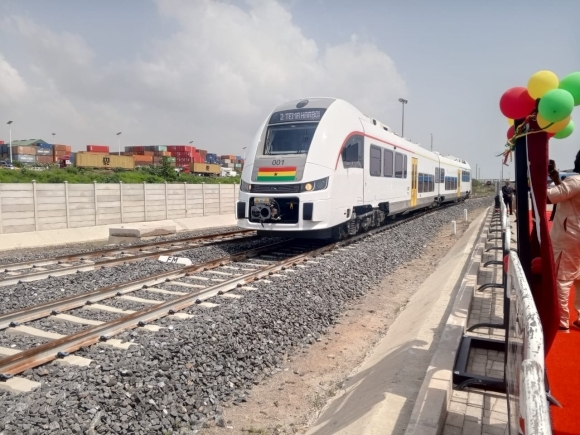Tema-Mpakadan railway remains idle six months after grand opening

Six months after its official commissioning on November 22, 2024, the much-anticipated 97.7-kilometre Tema-Mpakadan railway line remains non-operational, dashing commuters’ hopes for a reliable transportation alternative along Ghana’s Eastern Corridor.
The standard gauge railway—launched by President Nana Addo Dankwa Akufo-Addo and supported by two Diesel Multiple Unit (DMU) trains—was intended to enhance passenger and cargo movement. However, persistent challenges have stalled commercial operations.
Constructed at a cost of US$447 million through a credit facility from the India Export-Import Bank, the line was positioned as a major step toward revitalizing Ghana’s rail sector.
It includes new stations at Tema Port, Tema Industrial Area, Ashaiman, Afienya, Shai Hills, Doryumu-Jokpanya-Kodiabe, Kpone, and Adome, as well as a 300-metre rail bridge over the Volta River near Senchi.
The railway forms part of the broader Ghana–Burkina Faso interconnectivity project, aimed at linking Tema Port to the inland port at Mpakadan.
This would facilitate the transport of goods to northern Ghana and to landlocked neighbours like Burkina Faso and Niger.
Speaking in a radio interview on Citi FM on May 20, 2025, Dr Frederick Appoh, Acting CEO of the Ghana Railway Development Authority (GRDA), revealed that repeated incidents of theft and vandalism have delayed the start of operations.
“About 75 per cent of the damage has been repaired,” he said, adding that restoration efforts are being supported by the Ghana Investment Fund for Electronic Communications.
Dr Appoh also pointed to the lack of private sector participation as a significant obstacle, arguing that a state-run system has proven unsustainable and inefficient.
He emphasized the need for a public-private model, noting that globally, governments typically own railway infrastructure while private firms operate the trains.
To attract investors, the GRDA is developing an “open access model” for the railway, which will include track access charges and operational guidelines. A market-sounding exercise is scheduled for June 2025 to engage potential private partners. According to Dr Appoh, full commercial operations could begin by June 20, 2026.
The delay has frustrated many residents along the corridor who had hoped the rail service would alleviate road congestion, reduce transport costs, and speed up the movement of goods and people.
Despite the setbacks, Dr Appoh remains optimistic about the project’s economic potential. Citing the Nairobi–Mombasa railway in Kenya, he noted its capacity to create thousands of direct and indirect jobs, including opportunities in sectors like welding and machinery maintenance.
However, he admitted that the lack of a clear operational framework has discouraged private involvement—a gap the GRDA now aims to close.
At the commissioning event last year, President Akufo-Addo hailed the railway as a “lifeline” for local communities and businesses. But concerns about the line’s readiness were raised even before its opening. In April 2024, a truck collided with a train during a test run, leading to a six-month prison sentence for the driver and highlighting early operational risks.





